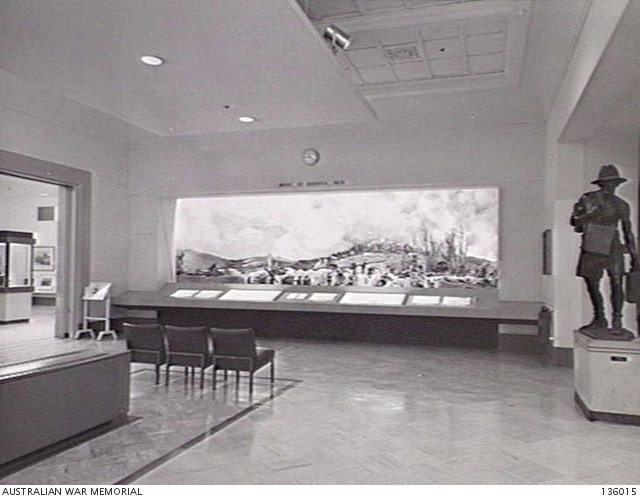Mont St Quentin and Péronne: Australian Victories
- 1918: Australians in France
- Battles
- Mont St Quentin and Péronne
The Aim
A photograph of the Mont St Quentin diorama, on permanent display at the Australian War Memorial.
The end of August found German troops at their last stronghold at Mont St Quentin - overlooking the Somme River and the town of Péronne. Mont St Quentin stood out in the surrounding country, making it a perfect observation point and a vital strategic area to control. This area was key to the German defence of the Somme line. As it was such an important area, Lieutenant General Sir John Monash was keen to capture it and thus possess a valuable position.
The Attack
This Australian operation is sometimes regarded as the finest achievement of the AIF. The 2nd Australian Division crossed the Somme River on the night of 31 August, and attacked Mont St Quentin at 5 am, from the unexpected position of northwest. It was a difficult position as it was an uphill fight for the troops, across very open ground where they were vulnerable to attack from the German-held heights above.
Rifle grenades and trench mortars were employed to outflank outpost positions. The battalions positioned to the right made a lot of noise to distract the Germans, while the centre and left battalions got a foothold on the hill and in Feuillaucourt.
Péronne, heavy artillery advancing through the town 1918, by Louis McCubbin.
By 7 am, the troops had gained the village of Mont St Quentin and the slope and summit of the hill, by working in small groups. The five German divisions were confused and dispersed, and many had fled. By midnight on 31 August, Monash's troops had captured 14,500 prisoners and 170 guns since 8 August. Allied troops also broke through lines to Péronne by 8.20 am on 1 September.
However, the Germans quickly regrouped and launched a counter-attack, and the first day of September saw fierce fighting and heavy losses. Germans attacked and heavily shelled Péronne. Much of the fighting was hand-to-hand combat.
The outnumbered Australians were pushed back off the summit of Mont St Quentin, and lost Feuillaucourt. Relief battalions were sent, and with their reinforcement, all the areas were retaken by the Australians, but at the cost of 3,000 casualties. Private Alex Barclay of the 17th Battalion was shot in the head by a sniper's bullet during the attack. Miraculously the bullet passed right through his skull, and he survived to re-enlist in the Second World War!
Members of the 6th Australian Infantry Brigade about to renew the assault on Mont St Quentin on 1 September 1918.
After heavy and exhausting fighting, the Australians established a stronghold on the area and forced the complete withdrawal of the Germans from Péronne. By the night of 3 September, the Australians held Péronne. They captured Flamicourt the next day, and advanced 2 miles to the east.
Soldiers from a machine-gun position established in the fighting in the ruins of Péronne, photographed on 2 September 1918.
Monash said of the Mont St Quentin and Péronne campaign that it
furnished the finest example in the war of spirited and successful infantry action conducted by three divisions operating simultaneously side by side.
The fight had also included battalions from every Australian state. British Commander General Lord Rawlinson remarked that this feat by the Australian troops under Monash's command was the greatest of the war.
Forced out of Péronne, the Germans had to retreat to their last line of defence- the Hindenburg Line.
Feature story: Private Robert Mactier




